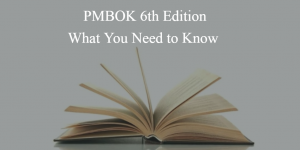
PMBOK (Project Management Body of Knowledge) is an internationally recognized project management guide published by PMI (Project Management Institute), with the first edition released in 1996. To stay in tune with evolving practices in business, project management professionals (PMPs) continuously work to improve processes and methodologies applied in project environments. Continual improvement and alignment of recommended best practices to an organization’s dynamic needs are essential to growth and success. PMI recognizes the ever-changing project management landscape, which has prompted a review and update of PMBOK. It is scheduled to be released in early 2017.
Based on some of the industry shifts, like the increased adoption of Agile, the 6th edition is expected to have more significant updates when compared to previous editions. PMI aims to remain compliant with traditional trends, while at the same time, improve the standards with some flexibility for innovation. One of the more notable changes is the book’s content organization by process groups rather than knowledge areas. The new edition will focus on project planning and documentation, as opposed to the traditional emphasis on tools and techniques.
Three New Processes Added
- ‘Manage Project Knowledge’: included in the executing process group and Project Integration Management knowledge area.
- ‘Implement Risk Responses’: included in the executing process group and Project Risk Management knowledge area.
- ‘Control Resources’: included in the monitoring/controlling process group and Project Resource Management knowledge area.
Two Existing Processes Removed
- ‘Estimate Activity Resources’: will be covered as part of the scheduling component.
- ‘Close Procurement’: will be combined with control procurements and close project.
Emphasis on Scheduling and a Broader Definition of Resources
In addition, two knowledge areas, Project Time Management and Project Human Resource Management, will be different in the new guide. Renaming “Project Time Management” as “Project Schedule Management” shows the importance of scheduling and aligns with PMI’s Practice Standard for Scheduling. On the other hand, “Project Human Resource Management” was renamed as “Project Resource Management” which covers both team and physical resources, such as project materials.
A WIN for Agile
With Agile being such a hot topic and a methodology being widely practiced, PMI has not only incorporated Agile and similar iterative practices in the various knowledge areas, but they also created a new “Agile in Project Management” section. This can be perceived as a win for Agile versus other traditional project management methodologies. Acceptance of this methodology by the leading project management institution is significant proof of the industry’s transformation and the book’s reinvention. Having an agile approach on international project management processes, maps and tools/techniques in new edition of PMBOK will require today’s PMPs to be more knowledgeable in this methodology and its applications.
While there is a strong association of Agile to IT, this does not mean that it is not applicable to manufacturing, construction or other industries. Cyclical processes identified with an agile practice will impact many parts of the new edition of the PMI guide. Even if PMBOK doesn’t name it, Scrum can also be a part of this change as the most frequently used cyclical process in project management. When we consider the expectation of a project manager to act as a product owner, Scrum may change both processes and definitions significantly.
Process + People + Technology = Success
The PMI Talent Triangle, which is composed of strategic and business management, leadership and technical project management abilities, will be another area to look for significant content enhancements. Long-term strategy development and business management will be inevitable skills to deal with the complicated and competitive project environment of global markets. Having the keen ability to keep project results aligned with the organizations’ strategic goals and managing market dynamics can help PMPs to differentiate themselves as leaders.
It is worthwhile to note that all of these changes do not occur in a vacuum. As an accredited organization by ANSI (American National Standards Institute), PMI requires a consensus and the inclusion of all stakeholders for the revisions and additions. Different from previous editions, a two-stage process is being followed for the draft of PMBOK – 6th Edition with the second review stage for the guide slated for June 26th – July 26th 2016. PMBOK committee is going to evaluate all recommendations carefully and approve those which are most applicable in a wide variety of project cases internationally.
While the 6th Edition is slated to be released in 2017, you have until early 2018 before the PMP certification exam will be updated. According to well respected PMPs, the updated guide will be a better and more advanced knowledge tool providing an enhanced study guide for new and seasoned project management practitioners.
PMI is a thought leader in how we approach project management with improvements in the recommended methodology influenced by dynamic market trends. We anxiously await the final version of the new PMBOK edition.
I hope you find this summary post useful. Please feel free to share your comments and ideas.
For more details & kick start your project management journey, sign up for our Microsoft Training Classes or send us an email.
I hope you find this blog post helpful. For more tips and tricks on Project Management, please visit www.epmainc.com

